Rebuilding with Resilience
dw0r306aHfX
dw0r306aHfX
Create successful ePaper yourself
Turn your PDF publications into a flip-book with our unique Google optimized e-Paper software.
RESILIENCE INTERVENTIONS<br />
The RBD proposals included many similar approaches for increasing the physical resilience of communities and<br />
addressing the water-based threats common to communities in the New York and New Jersey region. This section<br />
describes these approaches (or “resilience interventions”), which include natural and structural flood defenses,<br />
green infrastructure approaches for managing stormwater, and land-use (or “nonstructural”) strategies for ensuring<br />
that public and private development is designed and sited to be more resilient to flooding. This section discusses<br />
the common legal and policy challenges that the grantees are facing as they work to implement these resilience<br />
interventions, and describes opportunities for scaling and replicating these approaches throughout the project<br />
areas, and more broadly across these cities, the region, and beyond.<br />
FLOOD DEFENSES 15<br />
Most of the damage from Sandy resulted from storm surge; consequently, all of the RBD proposals focused, in<br />
one way or another, on interventions to reduce impacts from extreme storms. Sandy brought 12- to 14-foot storm<br />
surges, which overtopped flood defenses, battered beaches and wetlands, and inundated communities up and down<br />
the coast <strong>with</strong> several feet of floodwaters. This region is also anticipated to see 4 feet or more of additional sea-level<br />
rise over the next century, which will increase flood risks. 16<br />
As a result, all of the winning proposals developed innovative ideas for building “berms <strong>with</strong> benefits” — flood<br />
control structures that can provide other important everyday environmental, social, and economic benefits:<br />
• The BIG U proposal called for integrating flood protection into a city park and using deployable flood walls<br />
underneath raised highways where space is constrained;<br />
• The Living Breakwaters proposal called for the construction of breakwaters that would double as oyster<br />
reefs to dampen storm surge, enhance marine habitats, and reduce or reverse erosion of beaches; and<br />
• The Living <strong>with</strong> the Bay proposal called for living shorelines, restored marshlands, and constructed<br />
barrier islands to provide natural defenses to storm surge.<br />
The RBD proposals also often called for combining “gray” structural flood protection devices (such as berms or<br />
breakwaters) <strong>with</strong> “green” natural and nature-based approaches (such as restoring wetlands) to reduce impacts<br />
from storm surges. “Green” or “natural” defenses refer to approaches that restore, mimic, and enhance natural<br />
coastal features to reduce coastal flooding and erosion risk, including beach nourishment, dune management,<br />
living shorelines, 17 and wetland restoration. Natural defenses are a more ecologically beneficial way of addressing<br />
coastal flood risk compared to traditional “gray” or “structural measures,” 18 which rely on engineered structures<br />
designed to decrease shoreline erosion, dampen wave action, and protect against flooding. Structural measures<br />
include levees, storm surge barriers, sea walls, revetments, groins, and breakwaters.<br />
8 Chapter 1: Summary of Lessons Learned | <strong>Rebuilding</strong> <strong>with</strong> <strong>Resilience</strong> GEORGETOWN CLIMATE CENTER


